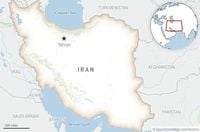Babak Shahbazi, a 44-year-old father of two, was executed by hanging in Iran on September 17, 2025, marking the latest in a string of executions targeting alleged spies accused of collaborating with Israel. The Iranian authorities claimed Shahbazi had gathered and sold sensitive information about data centers and security installations to Israel’s Mossad intelligence agency while working as a contractor on industrial cooling devices for companies linked to telecommunications, military, and security sites. Human rights groups, however, have sharply disputed the official narrative, alleging that Shahbazi was tortured into a false confession after he wrote a letter to Ukrainian President Volodymyr Zelenskyy offering to fight for Kyiv against Russia.
The execution took place at Ghezel Hesar Prison in Karaj, a site notorious for its grim history of capital punishment. Shahbazi’s case drew international attention, not only for the allegations of espionage but also for the disturbing details surrounding his arrest and trial. According to The Associated Press, Shahbazi was arrested in January 2024, and his trial was widely criticized by activists and watchdog groups for lacking fairness and transparency. Iran Human Rights, a leading Middle East watchdog, asserted that Shahbazi had been subjected to prolonged torture and solitary confinement before producing what they described as a false confession. The group stated, “Babak’s message to President Zelensky offering to help in the war against Russia was used as an example of espionage for Israel—who they absurdly claimed taught Babak how to use Microsoft Word.”
Iranian state media, as reported by The Sun, maintained that Shahbazi had used his position as an industrial refrigeration installer to collect intelligence from security rooms and data centers. They also linked him to Esmaeil Fekri, another accused spy who was executed in June 2025 on similar charges. The official account claimed that Shahbazi’s knowledge of Microsoft Word was presented as evidence of his connection to Israeli intelligence, a claim that human rights groups have ridiculed as baseless and indicative of the regime’s desperation to root out dissent.
The context for Shahbazi’s execution is a period of heightened repression in Iran following the 12-day war with Israel in June 2025. That conflict, which began with Israel’s Operation Rising Lion aimed at disrupting Iran’s nuclear program, resulted in devastating airstrikes on Tehran’s enrichment facilities and a deadly exchange that left approximately 1,100 people dead, including many Iranian military commanders. Iran responded with missile barrages targeting Israel, escalating tensions across the region. Since then, Iran has dramatically increased the number of executions for alleged espionage, with at least nine people put to death in recent months on similar charges.
This surge in executions is part of a broader crackdown by Iran’s leadership, which activists say is intended to stamp out rebellion and dissent amid mounting economic woes and ongoing protests over women’s rights. The third anniversary of Mahsa Amini’s death in police custody—a tragedy that sparked nationwide demonstrations—was marked just days before Shahbazi’s execution. According to The Associated Press, Iran has carried out executions at “an alarming rate” in 2024 and 2025, with a United Nations report putting the 2024 total at 975 and Iran Human Rights reporting over 940 executions already in 2025. The Sun reported that official records showed executions in 2024 reached 1,000, the highest in 30 years and a 16 percent increase over the previous year. Of those executed, 34 were women and seven were minors at the time of their alleged crimes.
The methods of execution and punishment in Iran have also drawn international condemnation. While hanging remains the most common method, there are reports of other medieval punishments, including public flogging, limb removal, and eye-gouging. The National Council of Resistance of Iran (NCRI) has expressed grave concerns that the true number of executions may be even higher, as many deaths are kept secret by the authorities. Harrowing accounts from inside Iran’s prisons reveal that thousands are languishing on death row for offenses ranging from political dissent to petty crimes. The Sun previously highlighted chilling footage of public executions, underscoring the climate of fear that the regime has fostered to maintain control.
Shahbazi’s execution has also been linked to the broader regional turmoil, particularly the ongoing war in Gaza. In the days following his death, Israel launched a new ground offensive in Gaza City, escalating a conflict that has already claimed more than 64,000 lives according to the Gaza health ministry. The Israeli Defense Forces (IDF) announced the operation as an effort to destroy Hamas’ military infrastructure, urging residents of Gaza City to evacuate to “humanitarian areas.” The United States, meanwhile, has warned Hamas that “time is running out” to reach a deal, with Secretary of State Antony Blinken expressing hope for a negotiated path to peace. The war in Gaza, which began in October 2023, has seen repeated cycles of violence, displacement, and humanitarian crisis, with the Israeli government remaining steadfast in its determination to eliminate Hamas.
As Iran’s regime faces increasing challenges at home and abroad, the use of executions as a tool of repression has become a flashpoint for international outrage. Activists argue that the government’s reliance on capital punishment, particularly for political prisoners and alleged spies, reflects a deep-seated paranoia and a desire to project strength in the face of mounting instability. The Associated Press noted that Iran’s judiciary has offered little transparency about the evidence against individuals like Shahbazi, and often refuses to acknowledge claims of torture or coerced confessions. Ukraine, for its part, did not immediately comment on Shahbazi’s execution, despite his letter to President Zelenskyy being cited as a key piece of evidence against him.
The case of Babak Shahbazi serves as a stark reminder of the peril faced by those accused of dissent or espionage under Iran’s current regime. As executions continue at a record pace and the government shows no sign of easing its crackdown, human rights organizations warn that many more prisoners remain at risk. The international community, including the United Nations, has repeatedly called for Iran to halt its use of the death penalty and to ensure fair trials for all defendants. Yet, for now, the cycle of repression and violence appears set to continue, casting a long shadow over the prospects for justice and human rights in Iran.
Shahbazi’s story, tragic and emblematic, highlights not only the personal cost of Iran’s crackdown but also the broader struggle for freedom and dignity in a nation riven by conflict, fear, and resistance.




